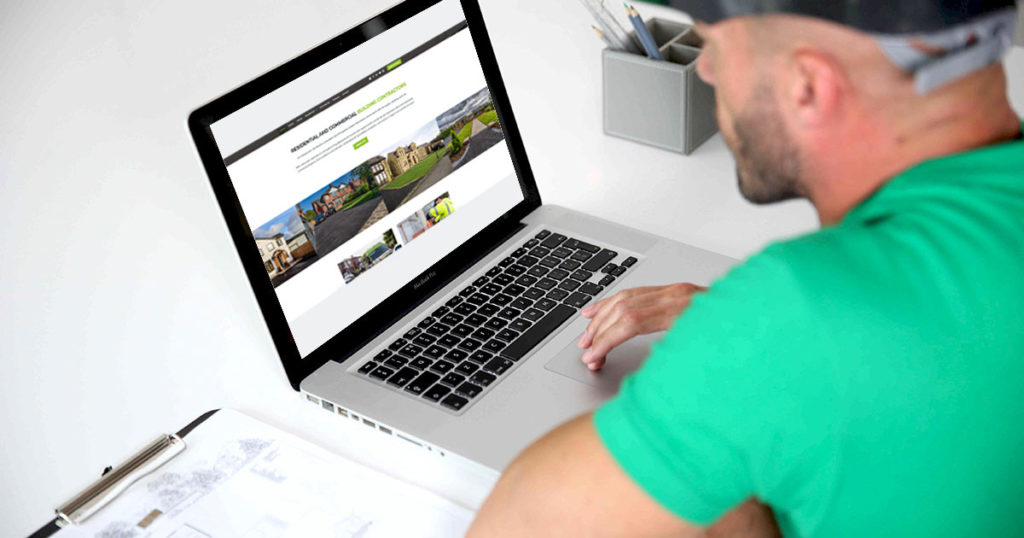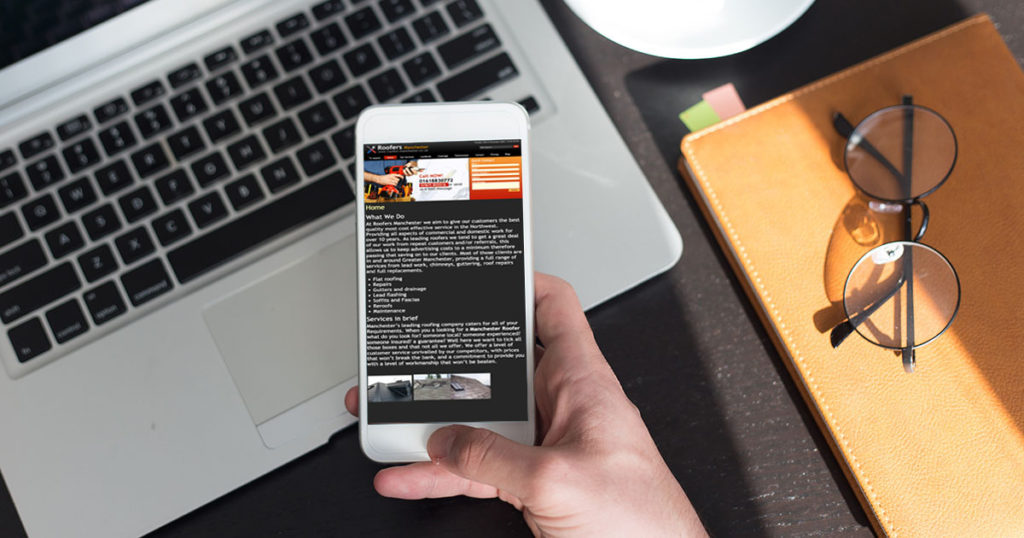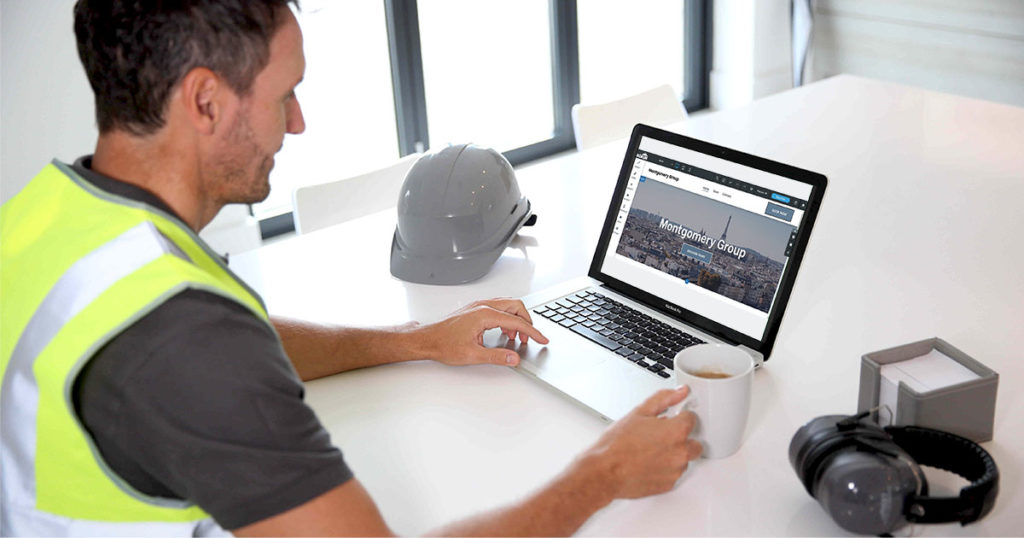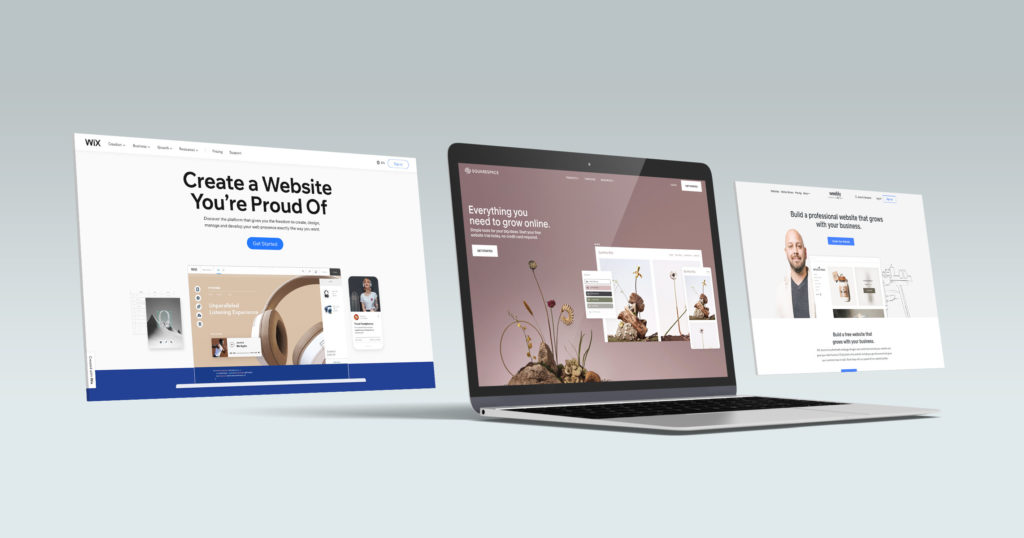
Want to know how good web design can boost your trade business?
We’ve got you covered! Web design is an important factor for a successful website, and having a successful website can bring in a lot of work for a tradesperson, and help build your business.
In this article we will go through:
- What is web design
- Why is it important
- Why is it different for tradespeople
- Benefits of having a website
- Marketing objectives
- Writing content
- What to include
- Making it look professional
- What to avoid
- Optimisation
- Outsourcing vs DIY
- Courses and tutorials
- Local vs National company
- Freelancers vs Agencies
- What is a website builder
- How website builders work
- Are they useful for tradespeople?
- Final tips for creating a trade website
As you can see we have a lot to go through, so let’s get started!
What is web design?

Web design involves the processes of planning and building all of the different elements of a website. It encompasses everything from the layout of images and text structure, through to the graphics, fonts and colours used. It creates the overall appearance and feel of the website.
Many components need to come together during web design, including user experience design, graphic design, interface design, content creation and search engine optimisation (SEO) that helps to drive traffic. All of these elements added together will determine the overall look and feel of the website, and how it is displayed and works on different devices. Remember, customers may access websites on both laptops or desktop computers as well as smartphones or tablets.
Web design differs from web development, but both are needed for building a website. Web development is concerned with the coding that makes websites work. Web development and web design are two distinct skill sets with web designers taking your ideas and turning them into a mockup of your website and handling the creative side, whereas web developers take the mockup that was created by the web designer and translate it into coding that can be displayed on the internet.
Why is web design important?
Your entire brand can be held back by a poor web presence. First impressions really matter, especially for tradespeople, and an easy to navigate, welcoming webpage can help drive customers your way.
Prospective customers often turn to the internet to find tradespeople. If they search for your brand and can’t find a website, they may think you have gone out of business. If they discover a badly designed webpage, they may think it is a reflection of your workmanship.
A well-designed webpage will professionally display all of the information potential customers are looking for, whilst being easy to navigate.
Why is web design different for tradespeople?
Web design for tradespeople should encourage visitors to the website to take action straight away. This is called a ‘conversion’. There are 7 principles of conversion-centred design that form the framework for the creation of high-conversion campaigns.
- Create focus: creating focus is the foundation of conversion-centred design. It is concerned with focusing potential customers on one goal at a time and holding their attention.
- Build structure: this is concerned with designing information hierarchy, setting the page layout, and how to structure the page to guide the audience to action.
- Remain consistent: consistent design across your pages and ad matching can bring in more conversions.
- Show benefits: choose images and visuals that showcase your work as a tradesperson and show the benefits potential customers could expect to enjoy.
- Draw attention: draw attention to the elements that are most important using design elements such as typography and colours.
- Design for trust: improve credibility and gain the trust of visitors to your site, with customer logos and testimonials.
- Reduce friction: optimise your online forms and mobile pages to make it as easy as possible for visitors to your webpage to convert, making the experience seamless to enhance conversions.
Why do tradespeople benefit from having a website?

- Increase visibility: if a potential customer searches the internet for your brand and finds nothing, they may think you are no longer in business. Having a well-designed webpage that can be shared via social media and what features highly in Google’s search rankings can help increase the visibility of your company.
- Professional first impression: first impressions really matter, especially when you are a tradesperson where attention to detail is essential. You will never get a second chance to make a good first impression. A well-designed webpage can give your brand a professional first impression that creates perfectly the experience your potential customer is looking for.
- Increase leads/sales: good web design should feature prominent and clear calls to action. Having an online presence allows your ethos and scope of work to be displayed to potential customers. Clear images can showcase your workmanship, whilst testimonials and reviews enhance trust in your brand. All of these will increase sales or leads.
- Give customers all the info they need/Save time: details of your brand and what work you can carry out should be clearly displayed on your webpage. Effective web design removes distractions whilst presenting important information in an easy-to-see format utilising different fonts, layouts and images.
- People will Google your business: especially after seeing your van or following a recommendation. The vast majority of households in the UK have internet access, and the internet is now often the first port of call for customers looking for tradespeople. Having an online presence and well-designed webpage can help convert these people into customers.
- 24/7 presence: a well-designed webpage gives your brand a 24/7 presence. Homeowners may search for tradespeople all hours of the day and night, plus on weekends and bank-holidays. You may not be able to answer your phone if you are working or having some well-deserved downtime over a weekend. A website makes sure customers can still view information about your business online.
- Get an edge over competitors: a well-designed webpage can showcase your workmanship and attract potential customers. Your brand’s website is one of its most valuable assets so it is important to ensure it trumps the competition and reflects the quality of your brand.
- Brand reinforcement: reinforce your brand and attract both new and repeat customers. Brand reinforcement maintains the equity of your company and will develop and grow as your brand develops and grows. Reinforcing your brand results in a greater awareness of it, driving potential customers towards it.
What marketing objectives should your trade website have?

- Build credibility: you want your brand to be credible. Credibility can come from accreditations or from verified customer reviews. Customers will want to know that you are insured, and are suitably qualified to carry out the work.
- Inform customers of services offered: your marketing strategy should clearly show customers what work you are able to offer. Potential customers do not want to have to search through various tabs or links, so the work you offer should be prominently displayed both in text and backed up by photographs of work you have completed.
- Build trust by showing existing work: showing images of existing work that you have completed can build trust and encourage potential customers to make contact. Images should be your own (no stock photos) and show a variety of different jobs. These can be accompanied by customer reviews.
- Receive leads; calls, forms, quotes: another marketing objective that should be considered when designing a website, is how to encourage conversions. A conversion may be a click-through, completing an online query form, applying for a quote, or making a call. A good call to action will help with increasing conversions.
- Inform customers of areas covered: when looking for tradespeople, customers need to know what areas you cover. If you are based in a certain town or city, it is important to give information on how far you will travel and the areas you cover. A larger service area will naturally result in a larger potential customer base.
- Inform customers of hours of operation: your website should have your hours of operation displayed somewhere prominent. This will help customers know when the best time to try and call you is, and also provides information on how long you may spend per day on a job. Many tradespeople offer 24-hour emergency call-outs, and this should be clearly displayed for customers to see if they’re in a hurry because of an emergency.
How do you write content for your trade website?

- Write to your audience: think about who will be visiting your website, and what they might want to know. Identify your audience’s ‘pain points’ or concerns and structure your website addressing them and reassuring the person reading.
- Know your demographics: think about the age, sex, ethnicity and socio-economic status of your target customer base. Are your customers more likely to be owner-occupiers, landlords, or private renters? Is there a large elderly population in your locale, or a high degree of relative poverty? All of these things will determine the language and tone of your website.
- Put the most important messages above the fold: important information should be displayed at the top of the page in what is known as a ‘hierarchy of information’. The most important information goes at the top and filters down to less important information nearer the bottom. The important information should grab and maintain the focus of the customer.
- Write short, simple sentences: a tradesman’s website should be written with short, simple sentences. Many customers may just skim read a page, and it is important to present information in a way that is easy to read. Avoid too many technical terms to enhance readability.
- Stick to active voice: an active voice is one that is purposeful and makes the information more concise and efficient. This is essential for creating dynamic online content. It makes for more engaging reading and helps the reader to gain trust in what you say.
- Show, don’t tell: video testimonials are a great way for customers to gain trust in your brand. They can showcase your work and add a degree of personalisation to your webpage. Recent, high-quality images of work you have recently completed can help show the quality and scope of your workmanship.
- Skip the jargon: there is nothing more off-putting than viewing a website and not being able to understand technical terminology. Remember, you are the expert. Those visiting your website may have little to no technical knowledge. Always use terminology that can be understood by those with no personal experience or knowledge of your specific trade.
- Promote your assets: ensure your webpage displays information that will gain the trust of potential customers. Displaying verified customer reviews, years of experience in the trade and professional accreditations can do this. As can showing the qualifications and specialist training you have received. Showing that you have the relevant insurance will also build trust.
What should be included on your trade website?

- Easy navigation: people want a website that is easy to use and navigate. This involves designing the website so visitors have quicker and more efficient access to the information and content they want. A clear menu structure makes it easy to navigate between pages. Not prioritising navigation and functionality can lose potential customers.
- Targeted website content: targeted website content is content that is created and designed for a niche audience. The aim is to drive a specific response from that target group. It helps customers to know what they need by reflecting an understanding of where they are in their customer journey.
- Portfolio/gallery: 91% of people believe visuals are useful on a website1. A portfolio or gallery showing high-quality images of work you have completed can help build trust in your brand. Never use stock photos or photographs that belong to someone else. Showcasing your work through an online gallery can show customers the scope and quality of your work.
- Social media links: if you have a Facebook, Twitter or Instagram page, include links to them on the website. Your social media pages should contain high-quality content and give potential customers the opportunity to engage with your company. Update your social media pages regularly.
- Written reviews: customer reviews are an excellent way for potential customers to gauge the quality of your work. Good customer reviews will increase trust in your brand. Verified reviews are one of the best forms of advertisement you can get. Showing that previous customers are happy with your workmanship and customer care will help convert potential customers.
- Video testimonials/explainers: video testimonials can help increase trust in your brand. Videos from previous customers showcasing the work you have completed can show the quality and scope of your work. Explainer videos can help show customers what is involved in the job they require.
- Mobile responsive: having a mobile responsive website optimises the page for customers who are viewing on a mobile device or tablet. Many people nowadays will use smartphones or tablets2 to access the internet and having a mobile responsive website ensures they are able to view the content and see all necessary information.
- Contact/quote form: having an online contact form allows customers to make contact quickly and easily without having to phone. A form allowing customers to fill in details for a quote can increase the conversion rate. You can also have an online form that allows customers to subscribe to a newsletter that can contain details of your work and any special offers.
- Call to actions: a call to action is a marketing device designed to encourage potential customers to take action, such as phoning, filling out an online form or making contact another way. A call to action is a phrase that tells potential customers what action to take and how to take it. It is typically written as an action or command phrase.
- Banner gallery: a banner gallery is an image or images that appear at the top of the webpage. A banner image is often called a ‘hero’ image. It helps your website look unique. The banner image or images should identify your brand and set the tone for the website. On website home pages or landing pages, the banner gallery can have a text overlay.
- Areas covered map: the website design should include a map that identifies the areas you cover. A visual map makes it easier for customers to see whether they are in your geographical service area than, say, a list of towns and cities. A map showing the area you cover will help ensure that only potential customers that are within your service area will make contact.
- Sales/job process: ensuring customers are aware of the steps that will be taken when they request your service can help build trust. Information on how to get a quote or book work and the average timescale for completing that work are vital elements to be included on your website. This ensures customer expectations are realistic.
- Email capture for ongoing updates to customers: a button or form on your website can capture email addresses from customers and potential customers as they sign up to a newsletter or email campaign. This would involve regular campaigns that are emailed to customers with details of special offers or availability for work.
- Blog/news: blogs still form an important part of a good website. Your blog content can be search engine optimised (SEO) which can increase your rankings on Google. Blog posts should be well researched and thoughtful. They help to keep your website content fresh and current. The blog can also be shared via social media, or an external blog hosting platform.
- Opening times: a list of your opening times will show customers what the best time to make contact is. If you offer a 24/7 emergency service, this can be added here. Opening times will give customers a realistic expectation of when they can expect you to return calls or emails, and also how long your standard working day is.
How can you make your trade website look professional?

- Pixel perfect design: pixel perfect design takes every element of your website into consideration, right down to each individual pixel. Careful attention is given to each pixel ensuring your design is sharp and clean. It helps to convey the image of a professional and modern website.
- Design that matches the brand: the design of your website should match your brand. If you have colours that are associated with your company, you should use them on the website. If you pride your company on professionalism and being modern, your web design should reflect this. Remember, your website is an extension of your brand.
- Website structured to serve marketing objectives: work out what you want your website to achieve and go from there. It is no good having a graphically impressive website if contact details are not easily accessible to customers. Every page on your site should serve a purpose and a hierarchical site structure ensures the most important information is displayed most prominently.
- Solid and consistent layout: the layout of your website should be consistent. You should work out all of the pages you want on your website and consider how they will connect. This makes the website easy to navigate and ensures all elements work harmoniously and provides a quality experience for your customers.
- Employ white space: white space enhances the readability of a webpage. It is the area between design elements and helps to break up the page and make it look less cluttered. White space does not have to be white, it can be a colour that is associated with your brand.
- Effective typography that highlights key messaging: typography is a powerful tool for conveying information to readers. It is concerned not only with the typeface, but also font size, colour, line length, and spacing. It enhances readability whilst highlighting pertinent information. Effective typography consists of an anchor text that will be used throughout the website, plus secondary fonts to be used in combination.
- Use the right images: use images to compliment the text on your website. Images can portray the service you offer and add personalisation. Always use your own pictures and not stock photos. High-quality images of your work and your team will instantly distinguish you from any competition.
- The right colour scheme: if you have a colour that is associated with your brand, then use it throughout your website on headers or maybe borders. Always ensure text can be read if it is on a coloured background – the text colour can be changed to make it more readable.
- Check browser compatibility: it is important to ensure that your website is compatible with different browsers. Access your site from a range of browsers (Safari, Firefox, Chrome etc.) and test it by filling out forms and clicking through links to ensure everything works as it should.
What to avoid when designing your trade website

- Making it cluttered: breaking up and cutting down cluttered elements conveys a higher degree of professionalism. Eliminate unnecessary elements and keep the pages clear of distractions. This makes your webpage sleeker and ensures visitors can find information quickly and easily.
- Strong, garish colours: if your choice of colours is wrong, visitors may leave your website in search of something more visually appealing. The colour used on your website should capture attention and focus the eye. Garish colours such as neons are difficult to look at and cause readability issues.
- Hard to navigate: a website that is hard to navigate will put off potential customers. Visitors want to be able to see important information and switch between pages with ease. If the site is difficult to navigate or there is no menu tab, for example, visitors are more likely to leave the site.
- Bad grammar: bad grammar on a website shows a lack of attention to detail. Poor spelling and grammar will damage your brand and credibility and visitors are likely to leave your website if they spot typos, spelling errors and poor grammar. Ensure all content that is on your site is proof-read.
- Old, broken code: broken links mean visitors will not be able to view content on your webpage. This makes for a poor user experience and can also damage your SEO efforts, negatively impacting rankings. Check your site periodically for broken links.
- Dated design: a dated design is less appealing and can leave visitors with a negative impression of your brand. Sites that are not mobile-friendly, have dated graphics or fonts, or that take a long time to load are all indicators of a damaging dated design.
- Not updating the website (security): from time to time, elements of your site will require updating. You will typically need to update when a developer adds functionality or releases a security patch. Updating a security patch protects your site from hackers, who will take advantage of security flaws.
- False claims: making false claims will damage your brand immensely. False claims leave you open to customer complaints and in extreme cases, you may find yourself liable to charges of fraud. The Advertising Standards Agency can take action over false claims which could lead to penalties or fines.
- Using other people’s content (written, photography, etc.): plagiarising other people’s content, such as text or images can seriously damage the reputation of your brand. There may be legal implications from using other people’s content without express permission. All content on your website should be unique to avoid breaching copyright.
- Putting important information below the fold or leaving off completely: it is crucial that your most important content is above the fold. Below the fold content requires visitors to scroll down to view. If there is no important or interesting content immediately visible when users click onto a page, they are likely to leave the website without scrolling down.
How to optimise a trade website

- Site speed, which is a ranking factor for SEO: site speed is a very important element for a website and it is a direct ranking factor. A fast site helps you to rank better on Google. The speed of your site can depend on a number of factors, such as scripts and images on a page. There are a number of tools available for developers to speed up the loading time of websites. Google’s PageSpeed Insight tool can check the page speed, and help to improve it. Compressing images, keeping things simple and clean, and having a good server can all help increase your site speed.
- Understand how tags work, semantic markup, H1s, H2s etc: optimising H1, H2 and H3 header tags can help to increase the ranking of your site. Search engines recognise text within header tags as being more important than the other text. They communicate to the search engine what your website is about. H1 tags should contain targeted keywords, with H2 and H3 being subheadings that should contain similar keywords to H1. Avoid stuffing keywords, as this will be recognised by the search engine and penalised. Semantic markups are the cornerstone of web development. They can improve your pages search rankings by using HTML tags to communicate to the search engine exactly what your page content is. This helps the search engine to index your content more quickly and accurately. Semantic markups result in better interoperability, accessibility and searchability.
- Create content that drives search traffic: choosing targeted keywords can drive traffic to your site, ensuring customers visit your site instead of your competitor’s. Researching the most popular keywords that are relevant to your brand and using them in your content can increase your rankings. It is important to remember that whilst your text should drive visibility and awareness, it should also be readable and user-friendly. Long-tail keyword phrases are phrases that are used when someone is looking for a specific item or service. These can be less competitive than single keywords, helping you to generate more traffic. Analytics can help you see what keywords and phrases are driving the most traffic.
- Reduce bounce rate: the bounce rate is the number of visitors that visit and then leave your landing page. A high bounce rate is an indication that your landing page needs a redesign. One reason visitors may leave your site is poor readability. Bad typography, colour choices and animated images all make it difficult for visitors to maintain focus. Ensuring you follow the information hierarchy can help keep visitors on your site which in turn will increase conversions. Keep information up to date and relevant, with a clear call to action.
- Mobile-friendly: up to 60% of people now use smartphones to access the internet, with only 16% and 8% using a laptop or desktop PC respectively3. Your website must be optimised for mobile devices. This means that all content is displayed correctly not just on PC or laptop screens, but also smartphones and tablets. Smartphone screens are smaller than PC screens, so it is even more important to ensure your menu and pages are simplified and can be easily navigated. Large blocks of text on the screen can be difficult to read so sentences should be as short as possible.
Should I build a website myself or have someone else build it?
When considering a business website, you generally have two options; contract the work out to a professional web designer, or build the website yourself. It is important to consider the pros and cons of both options.
Building a website yourself

Advantages of building a website yourself
- Save money: building and designing your website yourself can save you quite a bit of money in the short-term. There are free website builders available online which are ideal for those with no coding experience. They offer free templates and a drag and drop interface to put your elements into place. You will have to pay to use some tools such as web hosting and a domain name, but the overall cost will be considerably lower than hiring a professional web designer. With just a little bit of tech-knowhow, you can have a cost-effective website in no time.
- Work at your own pace: building your own website allows you to work at your own pace. You will need to prioritise your workload to give your website build the time it deserves, but being able to work on it whenever you have time is highly convenient. You will not have to wait for task turnaround times if you build your own site. You can decide what has the highest priority, and get it done at your own pace. With no third-party involvement, the timescale for building your website lies solely with you and you can get it done as quickly or slowly as you want.
- You know your business best: you know your business better than anyone else. Even if a web designer fully immerses themselves into your vision for your business, they still will not have the same knowledge of it as you will. They are experts in web design. You are the expert in your business. Your website will reflect the ethos of both your business and yourself, and it is important for visitors to get a feel for what you and your business are about. You will also know your target audience the best, and so can add content that you know will be relevant and useful to visitors to your site.
Disadvantages of building a website yourself
- You aren’t a pro: whilst there are website building sites available that can help to guide you through the process of building a website, it is still a complicated process that involves knowledge of marketing, design and software. Would you know how to view the analytics of who is visiting your site and the bounce rate? Could you create SEO optimised content? Do you understand HTML codes? You may be able to read about these online and gain a basic understanding, but for your website to really work well for you, you need a professional to take control of these things for you.
- May cost you to learn those capabilities: there are online or college courses that can teach you how to code. You can pay for basic training in web design, or take a course in SEO optimisation. These are costs that you will need to factor in when you build your website yourself. Additionally, factor in your time, and the potential cost of that time. You will be familiar with the term ‘time is money’. Building your own website may not be cost-effective when you factor in the time that it takes to build. Time that could be spent working instead.
- End product may look unprofessional: a website that looks unprofessional will reflect badly on your business. The wrong typography, poor images, using the wrong colour palette, or having broken links are all things that can make a website appear unprofessional. If you have no experience with web design, then it can be very difficult indeed to put together a high-quality website that oozes professionalism. Web designers are acutely aware of what looks good and what works, and, more importantly, what doesn’t. Visitors will view an unprofessional website as an extension of your brand, and will get the impression that you lack attention to detail, do not care about your brand, or try to cut corners and do things ‘on the cheap’.
- A lot of time is needed especially if you’re learning as you go: designing a website is a time-consuming affair. Even if you use an online website builder, you are still looking at around 2-5 hours per page4. This soon adds up. If you have no experience at all and need to learn as you go, the process will take considerably longer. Navigating your way through unfamiliar processes and learning even just the basics will take valuable time. That’s not to mention site optimisation, regular updates and ongoing maintenance. You will need to dedicate several hours to learning everything you need and putting that learning into practice.
- Site repairs and maintenance, site may not work properly: a website requires continuous updating and maintenance in order to keep it working as it should. Broken links or HTML code errors, or corrupted database files are a concern for all busy websites and can cause visitors to leave and not return. Errors will need rapid troubleshooting to get the site back running as it should. Without updates, your website may have security issues or leave it open to attacks from hackers. It is not as simple as creating a website and then leaving it to run itself. Ongoing repairs and maintenance take considerable time and specialist knowledge and are essential in keeping your site online and working properly.
Hiring A Professional

Advantages of hiring a professional
- They know what they are doing: professional web designers know what needs to be done, and how to do it. They will have extensive experience in creating a variety of websites for all kinds of businesses and industries. Mistakes in the creation and design of your website could cost you valuable time and this risk is eliminated through hiring a professional. If an issue arises with your website, then it will be them that will be contacting tech support, not you. Similarly, updates and ongoing maintenance will be covered, saving you time and, ultimately, money.
- They have access to tools and software: professional website builders and designers will have access to everything they need to create an amazing website. The software needed will already be downloaded to their computer, meaning you will not have to purchase it. They can ensure your site looks professional through their access to the necessary skills needed to create the best illustrations, images and graphics. They will be able to complete your website quicker than you would be able to do yourself through their access to a range of people with different skill sets such as development, analytics, SEO and content creation.
- The final product is going to look professional and function as intended: through their experience and dedicated skill set, a professional will ensure your website exudes professionalism, increasing the chances of visitors turning into conversions. With everything working as it should, such as links connecting to the correct pages and forms submitting correctly, customers will have more trust in your brand. Remember, your website is an extension of your business, and a professional-looking website will reflect the professionalism and attention to detail that you pride your brand on. If any issue arises – such as a broken link – you can rest assured that it will be picked up on quickly to ensure your site functions as it should at all times.
Disadvantages of hiring a professional
- Costly: there’s no skirting around the fact that hiring a professional is going to cost money. The cost of a professionally designed and built website is not going to be cheap, and you need to weigh up whether you believe the cost is worthwhile. The actual cost of the website is going to vary depending on the agency or professional you choose. However, choosing someone who offers to build the website for £100 will not give you the sort of quality and functionality as a professional or agency that charges £3000-£5000. As with most things in life, you get what you pay for.
- Need to research to find a good professional: when looking to hire a tradesperson, customers will research tradespeople in their area, get a variety of quotes, and ask around for recommendations. You should do exactly the same when looking to hire a professional to create your website. Make sure you research a web designer. Ask them for references or examples of their work in their portfolio. You will want to have an in-depth conversation with them to ensure their values align with yours and that you will be able to enjoy an ongoing, professional relationship. It is also a good idea to have a contract or agreement letter drawn up that shows a list of your expectations and timescales before committing to work with a professional.
- It is going to take time: creating a website is not going to happen overnight. It is vital that you have a realistic expectation with regards to turn-around times. A true professional will want to design and create a professional website. This may include multiple edits and revisions in addition to your input before the website is complete. If you request a lot of changes to the content, expect the timescale to be increased. It is also worth remembering that you will not be the only client the professional has. They will have other customers whose websites will be just as important as yours.
Are there any web design courses or tutorials for tradespeople?
It is possible to learn web design yourself, but you should be realistic about the timescales involved in learning the necessary elements. Web design is a valuable skill to learn, but there is a lot to learn and it will take time to familiarise yourself with the process. Don’t expect overnight results.
Companies such as Skillshare, Udemy, Treehouse and Code Academy offer online courses that can teach you different elements of web design. From analysing data through to building websites and coding, the companies offer a range of video tutorials and interactive learning.
Should I have a website built locally or from a national company?
Deciding whether to choose a local website builder or a national company is something you will want to carefully consider. There are a number of things you will want to take into consideration.
Having a website built by a local company

Advantages of hiring a local company
- Discuss requirement face-to-face: having a local website builder or designer allows you to discuss your requirements face to face. You can take in examples of your business cards or flyers as inspiration.
- Builds a trusting relationship: getting to know your designer personally helps to build a trusting relationship. Face to face discussions helps to ensure nothing is lost in translation through emails.
- If any problems arise, you can visit/reach out directly: if your designer encounters any problems or would like you to look over something, or if you wish to discuss any aspects of the design, it is easier to make contact or discuss things face to face.
Disadvantages of hiring a local company
- May not have access to the best expertise: choosing a designer based on your location reduces the potential talent pool. This is a particular concern if you live in a more rural location, where access to the best expertise will be limited.
- May be more expensive locally: choosing a local designer may be more expensive compared to national companies, where competition may be high and prices are more competitive.
Having a website built by a national company

Advantages of hiring a national company
- Choose from a wide range of suppliers to meet your specific requirements: choosing a national brand allows you to scour the market for a designer that can meet your specific requirements. Opting for a national brand opens up a wide range of different expertise.
- Compare and find the cheapest option: web design is a competitive market, and companies will try to offer the best deal. Getting a number of quotes and finding out what is included in that quote allows you to find the cheapest option.
- May get better results: choosing a national company with experienced designers may return better results than a local designer that may not be as experienced in designing the type of content you require.
Disadvantages of hiring a national company
- Companies could vanish or close: not knowing the company’s history or physical presence, unfortunately, makes it easier for dishonest people to claim to be able to complete the work you request, but then just vanish with your money. This is a risk when choosing an online designer.
- Harder to build trust: without a face to face relationship, it can be difficult to build trust with your designer. Telephone calls and emails do not offer the same personalised service as face to face conversations.
- Rely on them being contactable: there is nothing more frustrating than emails not being responded to or phones not being answered. It may be more difficult to contact your designer if they are part of a national brand.
- Development time could be longer: a national company may take longer to complete your website due to having multiple clients at the same time. Additionally, communicating via email can be a slow process.
Local vs National: Which is better?
Overall, choosing a national company for the development of your website is the better choice compared to a local developer. Looking nationally opens up a much wider talent pool and allows you to choose the designer who has the best expertise in completing your website to your specifications.
National companies will have access to various professionals in coding, content development, analytics, and other aspects that come together to ensure you receive a website that reflects your brand.
Whilst choosing a local developer allows you to form a relationship with your designer, you may end up paying more for the website due to not obtaining a number of different quotes. Whilst face to face communication is beneficial, advances in technology will allow you to communicate with a national developer through a variety of mediums such as Skype or Zoom, text messaging, live chat, emails and phone calls.
Do I use an agency or freelancer to design my trade website?
It can be difficult to decide whether to use an agency or a freelancer to design your website. There are a number of things to take into consideration when making your choice.
Hiring a freelancer for your website

Advantages of hiring a freelancer
- Cost may be cheaper: a freelancer may offer a per-project per hour price4. They work in their own time and are unlikely to demand an in-house, full-time salary. The cost may also be negotiable.
- Can set their schedule so the project may be done faster: freelancers are not limited by office hours or weekends and bank holidays. They set their own schedule and this can often involve completing work in the evenings and at weekends.
Disadvantages of hiring a freelancer
- Limited resources: a freelancer will have a much more limited skillset compared to an agency that will employ a number of professionals with skills in all areas of web design.
- They can suddenly become unavailable: life is unpredictable, and even freelancers may have something come up that means they are no longer available. This could mean you have to start all over again with someone else.
- No contract: an agency will offer a contract detailing the work to be completed along with cost and timescale. Freelancers are less likely to offer this protection, making it difficult to hold them accountable for poor or no work.
- Harder to assess reviews and experience: an agency is likely to have a large number of previous customers. They are more likely to have easily accessible and verified customer reviews compared to a freelancer.
Hiring an agency for your website

Advantages of hiring an agency
- Diverse experience: agencies can offer a range of website builders and designers with a huge range of skills and experience. The more experience your designer has, the better the end result will be.
- Credibility and support: agencies have a reputation to uphold giving them more credibility. Online reviews and awards in addition to past client work make the company credible. As does on-going support.
- Refined processes: an agency will have a number of processes in place. For example, multiple team members may review and ensure the quality of the design before it is approved. This can help with time and cost.
Disadvantages of hiring an agency
- The cost can be expensive: digital agencies have huge overheads. They may work out of rented office spaces and will have a large team of specialists who come with a large price tag.
- The process is often overkill for a small business: a digital agency with a wide range of specialists may be overkill if you have a small business. The costs and time associated with the design may not be worthwhile.
- You won’t get to pick who you work with: the agency will allocate you a designer, who will be picked at random. If you have a large business, you may get an experienced designer; however, small businesses may get someone with less experience.
- Less personal: a freelancer is more likely to offer a more personal approach as you are likely to be their sole client. This relationship is usually not formed with workers from agencies.
- The project could be postponed in favour of bigger businesses: with an agency, you will not be their only client. Your project may get bumped down the list of priorities if they have a bigger business to work with.
So what should you go for?
Both freelancers and agencies are costly options, although it may be cheaper with a freelancer.
Freelancers are likely to be the best option for designing your website due to you being able to have a more personal relationship. Additionally, your project is likely to be the only thing they are working on at the time so the creation time may be lower than what an agency can offer.
However, there are other options available that can reduce the cost of building your website, including using website builders. There are also expert companies that specialise in building and designing websites specifically for tradespeople. This specialised knowledge can ensure you end up with a website that best suits the needs of both you and your customers.
What is a website builder?

A website builder is an online tool that makes it much easier for people with no technical skills to design their own websites. There is no coding or specialist knowledge required and with a little bit of research, even beginners can create and design their own website.
Website builders make it easy to maintain your website, you can edit it any time from your computer. A website builder allows you to create and design a website without the costs associated with freelancers or digital agencies, and it can be completed according to your own timescales.
How do website builders work?
A website builder utilises user-friendly drag and drop technology to help you create your own website. There are professionally-designed templates available that you can customise to suit your own style.
Simply select the template that best fits the look of your business, and edit the built-in elements with your own content such as text boxes, images, social media buttons, quote/contact forms and videos.
Website builders tend to be low maintenance once they are up and running. The website will need updating with fresh content periodically, but there tends to be no complicated updates or maintenance required.
Website builders include hosting for a small fee.
There are two main types of website builders: online and offline.
An offline builder comes as downloadable software programs that you install onto your computer. You complete the build of your website online and save it to the files on your computer. An advantage of this is that you can work on your website from anywhere, even if you do not have an active internet connection. When your site is complete, you upload the files to a web host.
An online website builder runs on the provider’s service, meaning you do not need to download any software to your computer. An online website builder is more suited to people with minimal experience in coding.
Are website builders useful for tradespeople?

Website Builder Pros
- A relatively simple path to creating a web presence: a website builder is a quick and easy path to creating a web presence. Using the templates provided, you could publish your site in a matter of hours. Updating content is quick and easy, ensuring your site remains relevant.
- Easy to use: no previous experience or design skills are needed to create a website using a website builder. Simply drag and drop elements you want to be included onto a pre-designed template, and voila, you have a website!
- Include hosting and sometimes cover the registration of a domain name: for a small monthly or annual fee, website builders include hosting. Some even cover the registration of a domain name. They can also include a personalised business email address which boosts professional credibility.
- Cheap option: website builders are much cheaper than hiring a freelancer or design agency. You can have a website designed and published for a small monthly or annual fee, which includes hosting, domain name and email address.
- Can use predefined templates: the predefined templates make designing your website incredibly quick and easy. Some builders even ask for details of your business and will recommend templates based on your answers.
Website Builder Cons
- They aren’t very flexible: website builders have limited pages and features. With that in mind, they are more suited to smaller businesses. As your business grows, you will want to move away from the website builder and hire a designer.
- Require design skills: although website builders have predefined templates, you will still need some level of design skills. Knowing what typography, colours, images and layouts to use are all important aspects to make the site professional and maintain the attention of visitors. A poorly designed site will result in a high bounce rate and could damage your business.
- Need marketing and SEO knowledge: a successful website needs great marketing and high rankings, which come from SEO content. Good marketing results in holding the visitor’s attention and encouraging them to take action. SEO content involves the use of keywords and phrases within the content. But not too many keywords; keyword stuffing gets penalised and results in lower rankings!
- Users need to understand interfaces (UI) and user experience (UX): the user interface is the series of pages, screens and visual elements such as icons and buttons that enable a visitor to interact with the website. User experience is the personal experience a visitor has as they interact. This can be positive, negative or neutral.
Should a tradesman use a website builder?
Building a website using a website builder can be quick and easy. However, building a good website will take much more time and effort. A successful trade website will result in visitors taking action such as requesting a quote or enquire about booking. Your website needs to generate work and to do that, visitors need to be able to have trust in the professionalism of your business.
Learning the skills needed to create a successful website will take time, and may cost money. You need skills in design, typography, colour palettes and SEO. SEO is one of the most important elements as it will drive traffic to your site. It is not worth having a great website if no one can find it on the web.
You need to consider whether you can dedicate the time needed to learn the skills required for a successful website design, or if you should delegate the job to someone else such as a freelancer or design agency.
Final tips for creating a trade website
A trade website can help increase your customer base by having an online presence. A well-designed website increases trust in your brand and can show professionalism. The aim of a trade website is to encourage visitors to take action, whether that is requesting a quote, filling out a contact form, or phoning or emailing.
A poorly designed website can make visitors think you do not care about your business, or that you lack professionalism. Websites should be optimised both for laptop and desktop computers, but also for smartphones and tablets. A poorly optimised site will put visitors off.
Showcasing your work through high-quality images or videos, and having customer reviews will increase trust and give visitors an idea of the scope and quality of your work. Links to your social media pages (which should be regularly updated) will also increase trust and engage visitors.
There are a number of options available to you when considering a trade website. Website builders are ideal for smaller businesses and are a quick and cost-effective solution. However, they may appear unprofessional if not done correctly, and there are limitations to their functionality. Larger businesses may want to consider either a freelancer or design agency to complete the website design. These options are more expensive and may take longer, but the website will look professional and have great functionality and usability. They will also ensure the website is protected from hackers with security updates, and troubleshoot any broken links.
When considering which option is best for you, it is worth considering how much spare time you have, and what your budget is. If you choose a freelancer or design agency, get a number of quotes and compare what is included in the price. If you have a small business or limited budget, then your best option will be a website builder. However, larger businesses will want to utilise the skills of a professional developer.
Questions
Web design for tradespeople should encourage visitors to the website to take action straight away. This is called a ‘conversion’. There are 7 principles of conversion-centred design that form the framework for the creation of high-conversion campaigns.
1) Create focus
2) Build structure
3) Remain consistent
4) Show benefits
5) Draw attention
6) Design for trust
7)Reduce friction
Prospective customers often turn to the internet to find tradespeople. If they search for your brand and can’t find a website, they may think you have gone out of business. If they discover a badly designed webpage, they may think it is a reflection of your workmanship.
Increase visibility, professional first impression, increase leads/sales, give customers all the info they need, save time, people will Google your business, 24/7 presence, get an edge over competitors, brand reinforcement.
Build credibility, inform customers of services offered, build trust by showing existing work, receive leads; calls, forms, quotes, inform customers of areas covered, inform customers of hours of operation.
Write to your audience, know your demographics, put the most important messages above the fold, write short and simple sentences, stick to active voice, have video testimonials and reviews, skip the jargon, promote your assets (years of experience, insurance cover, accreditations, training etc).
Some things you need to make sure your trade website has:
Easy navigation, targeted website content, portfolio/gallery, social media links, written reviews, video testimonials/explainers, mobile responsive, contact/quote form, call to actions, banner gallery, areas covered map, sales/job process, email capture for ongoing updates to customers, blog/news, opening times.
Pixel perfect design, design that matches the brand, website structured to serve marketing objectives, solid and consistent layout, employ white space, effective typography that highlights key messaging, use the right images, the right colour scheme, check browser compatibility.
Making it cluttered, strong and garish colours, hard to navigate, bad grammar, old and broken code, dated design, not updating the website (security), false claims, using other people’s content (written, photography, etc.), putting important information below the fold or leaving off completely.
Pay attention to site speed, which is a ranking factor for SEO, understand how tags work; semantic markup, H1s, H2s etc, create content that drives search traffic, reduce bounce rate, make it mobile-friendly.
DIY Pros: Save money, work at your own pace, you know your business best.
DIY Cons: You aren’t a pro, may cost you to learn those capabilities, end product may look unprofessional, a lot of time is needed especially if you’re learning as you go, Site repairs and maintenance, site may not work properly.
Hiring a professional Pros: They know what they are doing, they have access to tools and software, the final product is going to look professional and function as intended.
Hiring a professional Cons: Costly, need to research to find a good professional, it is going to take time.
Companies such as Skillshare, Udemy, Treehouse and Code Academy offer online courses that can teach you different elements of web design. From analysing data through to building websites and coding, the companies offer a range of video tutorials and interactive learning.
Local Company Pros: Discuss requirement face-to-face, builds a trusting relationship, if any problems arise, you can visit/reach out directly.
Local Company Cons: May not have access to the best expertise, may be more expensive locally.
National Brand Pros: Choose from a wide range of suppliers to meet your specific requirements, compare and find the cheapest option, may get better results.
National Brand Cons: Companies could vanish or close, harder to build trust, rely on them being contactable, development time could be longer.
Both freelancers and agencies are costly options, although it may be cheaper with a freelancer. Freelancers are likely to be the best option for designing your website due to you being able to have a more personal relationship. Additionally, your project is likely to be the only thing they are working on at the time so the creation time may be lower than what an agency can offer.
A website builder is an online tool that makes it much easier for people with no technical skills to design their own websites. There is no coding or specialist knowledge required and with a little bit of research, even beginners can create and design their own website.
A website builder utilises user-friendly drag and drop technology to help you create your own website. There are professionally-designed templates available that you can customise to suit your own style. Simply select the template that best fits the look of your business, and edit the built-in elements with your own content such as text boxes, images, social media buttons, quote/contact forms and videos.
Pros: A relatively simple path to creating a web presence, easy to use, include hosting and sometimes cover the registration of a domain name, cheap option, can use predefined templates.
Cons: They aren’t very flexible, require design skills, need marketing and SEO knowledge, users need to understand interfaces (UI) and user experience (UX).

